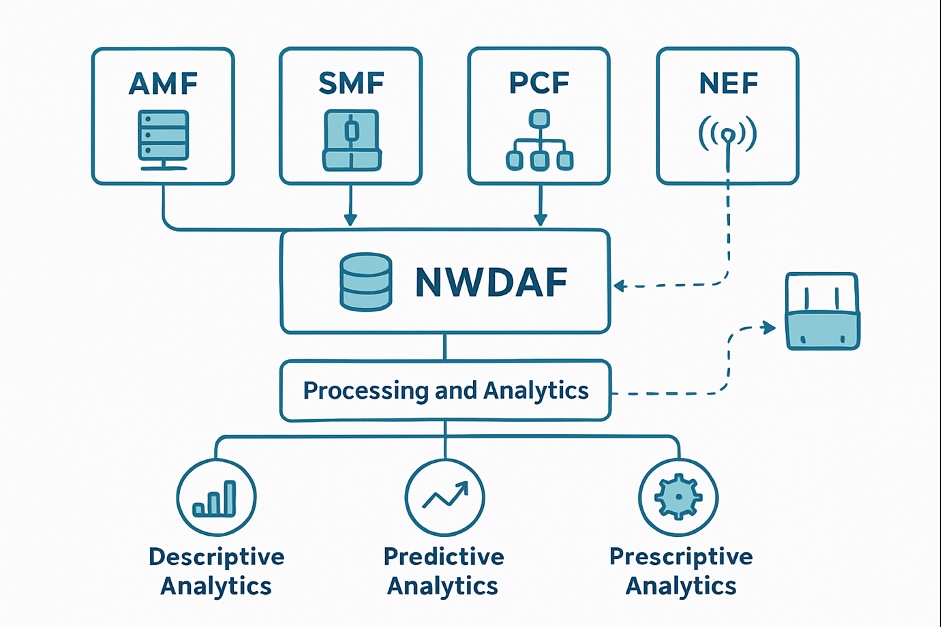NWDAF: How 5G is AI Native by Essence
The evolution of telecommunications networks has always been characterized by increasing complexity and intelligence. As we’ve moved through successive generations of wireless technology, I’ve observed a consistent trend toward more adaptive, responsive systems. With 5G, this evolution has reached a critical inflection point by introducing the Network Data Analytics Function (NWDAF) a component that fundamentally transforms how networks operate and adapt.
The evolution of telecommunications networks has always been characterized by increasing complexity and intelligence. As we’ve moved through successive generations of wireless technology, I’ve observed a consistent trend toward more adaptive, responsive systems. With 5G, this evolution has reached a critical inflection point by introducing the Network Data Analytics Function (NWDAF) a component that fundamentally transforms how networks operate and adapt.

NWDAF, introduced in the 5G Core architecture starting from Release 15 and continuing to evolve toward 6G, represents a pivotal element in the Service-Based Architecture (SBA). More than just another network component, it embodies a philosophical shift toward data-driven, intelligent network operations that anticipate the needs of both users and applications.
At its core, NWDAF serves as a standardized network function that provides analytics services to other network functions, applications, and external consumers. Its functionality spans the entire analytics lifecycle: collecting data from various network functions (including AMF, SMF, PCF, and NEF), processing and analyzing that data, generating actionable insights and predictions, and feeding decisions back into the network for optimization and policy enforcement.
I often describe NWDAF as the “central intelligence of the network”—a system that transforms raw operational data into practical insights that drive network behavior. This transformation is not merely incremental; it represents a fundamental reimagining of how networks function.
The necessity for NWDAF becomes apparent when we consider the demands placed on modern networks. Autonomous networks require closed-loop automation for self-healing and self-optimization—capabilities that depend on the analytical insights NWDAF provides. Quality of Service assurance increasingly relies on the ability to predict congestion, session drops, or mobility issues before they impact user experience. Network slicing, a cornerstone of 5G architecture, depends on real-time monitoring and optimization of slice performance. Security analytics benefit from NWDAF’s ability to detect anomalies or attacks through traffic behavior pattern analysis. Furthermore, NWDAF’s flexible deployment model allows it to operate in either central cloud environments or Multi-access Edge Computing (MEC) nodes, enabling localized decision-making where appropriate.
The integration of NWDAF with other network functions occurs through well-defined interfaces. The Np interface facilitates data collection from various network functions. The Na interface enables NWDAF to provide analytics to consumers. The Nnef interface supports interaction with the Network Exposure Function, while the Naf interface enables communication with Application Functions. This comprehensive integration ensures that NWDAF can both gather the data it needs and distribute its insights effectively throughout the network.
The analytical capabilities of NWDAF span multiple dimensions. Descriptive analytics provide visibility into current network conditions, including load metrics, session statistics, and mobility patterns. Predictive analytics enable the network to anticipate issues before they occur, such as congestion prediction, user experience degradation forecasts, and mobility failure prediction. Looking forward, prescriptive analytics will eventually allow NWDAF to suggest automated actions, such as traffic rerouting or slice reconfiguration, further enhancing network autonomy.
As we look toward 6G, NWDAF is poised to evolve into an even more sophisticated component of network architecture. I anticipate the development of an AI/ML-native architecture where NWDAF evolves into a Distributed Intelligence Function. Federated learning approaches will enable cross-domain learning without requiring central data sharing, addressing privacy and efficiency concerns. Integration with digital twin technology will allow simulated networks to feed NWDAF with predictive insights, enhancing planning and optimization. Perhaps most significantly, NWDAF will increasingly support intent-based networking, where user intentions are translated directly into network behavior without requiring detailed technical specifications.
The journey toward truly intelligent networks is just beginning, and NWDAF represents a crucial step in that evolution. By embedding analytics and intelligence directly into the network architecture, 5G has laid the groundwork for networks that don’t just connect—they understand, anticipate, and adapt. This foundation will prove essential as we continue to build toward the even more demanding requirements of 6G and beyond.
Prepared By: Amr Ashraf | Head of Solution Architect and R&D | Digis Squared
Share:
